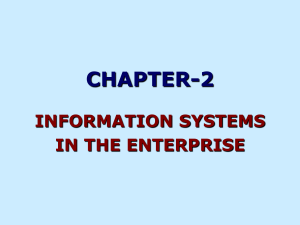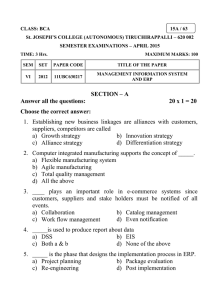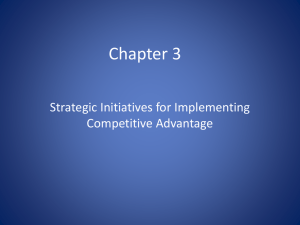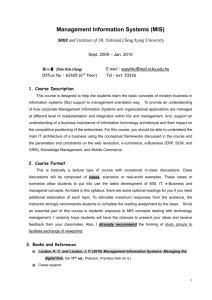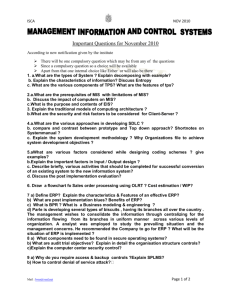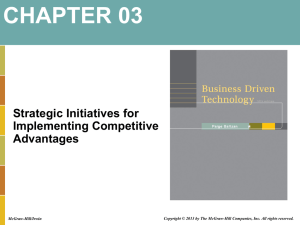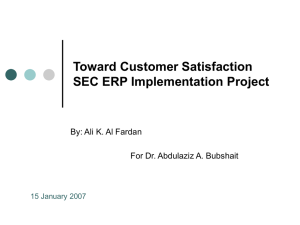Business process reengineering (BPR) is, in computer science and
advertisement
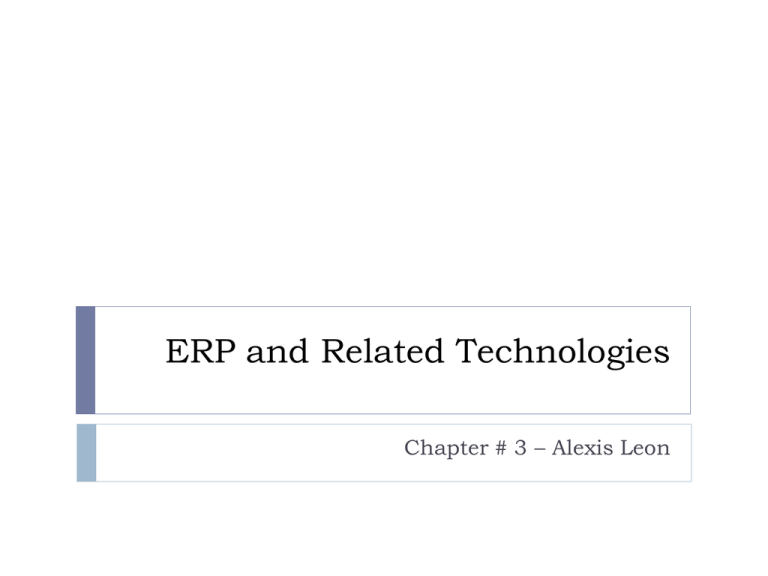
ERP and Related Technologies Chapter # 3 – Alexis Leon ERP Systems Limitations ERP Systems serve an important function by integrating separate business functions – Materials Management, Production Planning, Sales, Distribution, Finance, and Accounting etc. into a single application. However, ERP Systems have three significant limitations: 1. Managers cannot generate custom reports or queries without help from a programmer and this inhibits them from obtaining information quickly, which is essential for maintaining a competitive advantage 2. ERP Systems provide current status only, such as open orders. Managers often need to look part the current status to find trends and patterns that aid better decision making. 3. The data in the ERP application is not integrated with other enterprise or division systems and does not include external intelligence Related Technologies to Overcome ERP Limitations Business Process Reengineering (BPR) Management Information System (MIS) Decision Support Systems (DSS) Executive Information Systems (EIS) Data Warehousing Data Mining On-Line Analytical Processing (OLAP) Supply Chain Management Business Process Re-engineering Business process reengineering (BPR) is, in computer science and management, an approach aiming at improvements by means of elevating efficiency and effectiveness of the business process that exist within and across organizations. Business Process Re-engineering Business process reengineering is one approach for redesigning the way work is done to better support the organization's mission and reduce costs. BPR Methodology Starting with mission statements that define the purpose of the organization and describe what sets it apart from others in its sector or industry. Producing vision statements which define where the organization is going, to provide a clear picture of the desired future position. Build these into a clear business strategy thereby deriving the project objectives. Defining behaviors that will enable the organization to achieve its' aims. Producing key performance measures to track progress. Relating efficiency improvements to the culture of the organization Identifying initiatives that will improve performance. Management Information Systems (MIS) MIS is a computer-based system that optimizes the collection, collation, transfer, and presentation of information throughout an organization. Decision Support Systems It helps organizations such as businesses to analyze data about current situations, compare available options and assess probable outcomes. Decision Support Systems are interactive information systems, that rely on integrated set of user-friendly software and hardware tools, to produce and present information targeted to support management in the decision making process. Executive Information System EIS is a Decision Support System especially made for senior-level executives. EIS Considerations: The overall vision and mission of the company and the company goals Strategic Planning and Objectives Organizational structure Crisis Management and Contingency Planning Strategic Control and Monitoring of overall operations Data Warehousing The primary concept of data warehousing is that the data stored for business analysis can be accessed most effectively by separating it from the data in operational systems. Data Mining Data Mining is the process of identifying valid, novel, potentially useful and ultimately comprehensible information from databases that is used to make crucial business decisions. Modeling the investigated system discovering relations that connect variables in a database are the subjects of data mining. OLAP-Online Analytical Processing Fast Analysis of Shared Multidimensional Information FAST means that the system is targeted to deliver most responses to users within five seconds ANALYSIS means that the system can cope with business logic and statistical analysis that is relevant for the application and the user, and keep it easy enough for the target user. SHARED means that the system implements all the security requirements for confidentiality MULTIDIMENSIONAL means that the system must provide a multidimensional conceptual view of the data INFORMATION is refined data that is accurate, timely, and relevant to the user Supply Chain Management Network of facilities and distribution options that performs the function of procurement of materials, transformation of these materials into intermediate and finished products, and the distribution of these finished products to customers.

